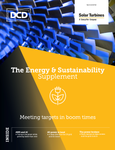Data center energy use is in the spotlight like never before, as a ferocious AI data center build out puts pressure on an increasingly strained grid.
In this latest Supplement, we look at this friction point, and what the future holds for the data center sector.
The power brokers
We spoke to Brian Janous, Microsoft’s former VP for energy, who struck out alone earlier this year to form his own company, Cloverleaf Energy.
Janous has seen an opportunity to buy up land for data center companies, and work with utility providers to improve power infrastructure.
He believes a lot of companies are “playing catch-up” when it comes to energy, and because of this, their energy strategies are not up to scratch. He plans to partner with utilities to introduce additional batteries and other grid-enhancing technologies to the grid to ensure capacity can be increased. “Turning electricity into data is one of the most profitable businesses in the world,” he said.
The cloud challenge
Cloud providers set ambitious renewable energy goals for 2030. And then the AI boom happened, and those plans went out the window.
We chatted to Chris Walker, AWS head of sustainability, about how it's keeping up. “I feel confident in the team and we'll be able to deliver on our 2030 goal five years early,” he said.
The grid matter
In the US, the fragmented nature of the network means addressing the transmission problem at the federal level is difficult.
According to IDC analyst Sean Graham, in the US, “all power is local,” which means operators need to look for systems that meet the unique needs of their networks. Microgrids could be an option, but are not without their drawbacks, particularly when it comes to cost.
The great filter
Apple is taking steps to make its data centers more sustainable by replacing its disposable air filters with washable, reusable, versions. While filters may seem relatively trivial when compared to the high-value server components that pack AI data centers, they play a vital role in keeping equipment running, and, because their job is to catch dirt, dust, and other harmful particulates, have a limited shelf life.
Apple worked with K&N Filtration to develop a reusable filter that it thinks will last for 15 years. The project utilized K&N’s experience creating similar devices for high-performance automotive applications and has apparently already saved Apple from sending 25 tons of waste to landfill, which is not to be sniffed at.

